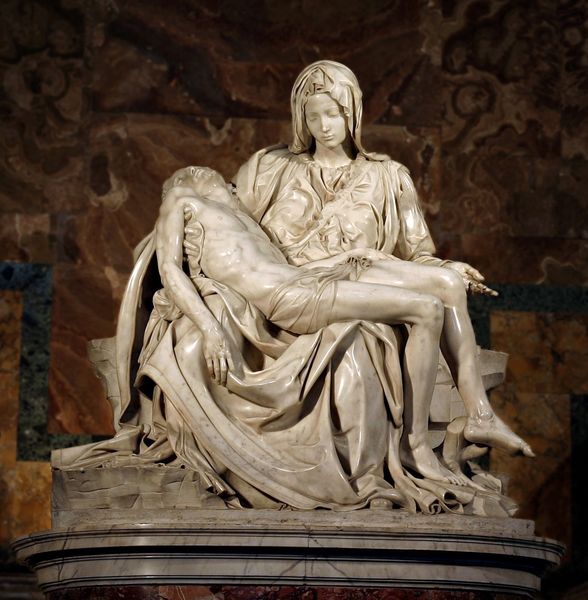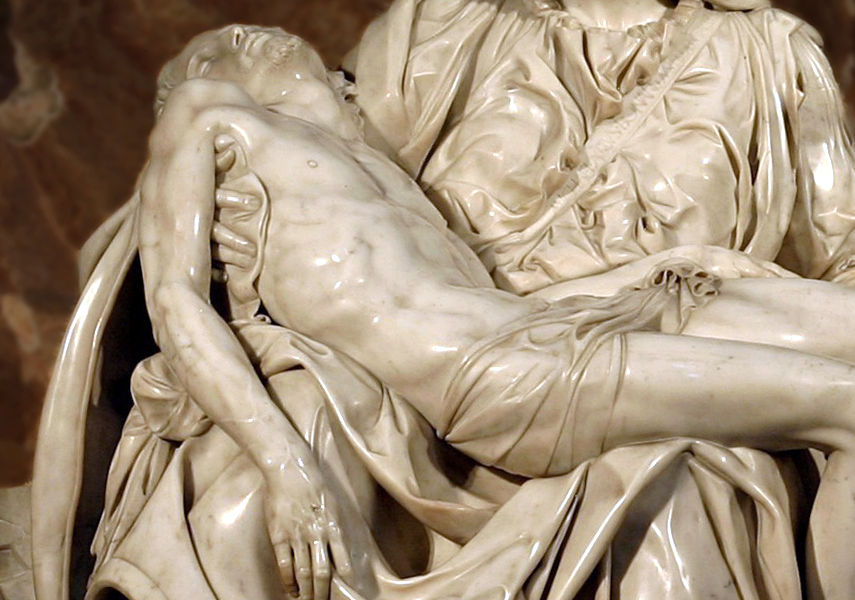A Masterpiece in Marble - Examining Michelangelo's Pietà
"I'm Jesus Christ!" echoed in the side chapel of the St. Peter's Basilica in Rome in 1972, mixed with a crushing sound of broken marble. The shouts came from a red-haired young Australian guy with a beard who climbed over a balustrade, went up to the platform on which Michelangelo's sculpture Pietà rested, and started battering the famous statue with a hammer.
The attack left the revered religious composition severely damaged: the blows destroyed the Virgin Mary's left arm, chipped her nose and the left eye, and crumbled the veil that covered her hair. Soon after, donning a red cape over his white cassock, Pope Paul went to see the statue and was heard commenting, "Also most serious moral damage." He later sent roses to be placed in front of the sculpture, by then covered with a red drape.
Michelangelo's Pietà is perhaps the most well-known religious sculpture in the world. Created when Michelangelo was only 24, it is among the artist's most renowned pieces and one of the rare ones he finished. Protected today with unbreakable glass, it can be seen in St. Peter's Basilica in the Vatican.

Michelangelo's Pietà
Born in Florence, the celebrated Renaissance artist Michelangelo Buonarroti (1475-1564) was commissioned in 1498 by Cardinal Jean de Bilhères, ambassador of the king of France, to create Pietà for his burial chapel. The banker Jacopo Galli acted as an intermediary for the young Italian artist.
At the time, Michelangelo was living in Rome, where he moved after working in Florence for the Medici family. While in Rome, he only completed two sculptures, a lost Cupid-Apollo composition that has been lost and a Baccus for Galli. After the agreement with Bilhères, the cardinal wrote to the officials of the state of Lucca, known for its marble quarries, including Carrara, urging them to help Michelangelo find the marble for the new statue.
"We have recently agreed with master Michele Angelo di Ludovico, Florentine sculptor and bearer of this, that he make for us a marble tombstone, namely a clothed Virgin Mary with a dead Christ naked in her arms, to place in a certain chapel, which we intend to found in St. Peter’s in Rome," he wrote. "And on his presently repairing to those parts to excavate and transport here the marbles necessary for such a work, we confidently beg your lordships out of consideration for us to extend to him every help and favour in this matter."
Michelangelo spent a month in Carrara at the end of 1497 searching for the suitable marble he needed, and soon after started working on the new composition. When the statue was finally installed in 1500, the cardinal had already died. The sculpture was unveiled in the chapel of Santa Petronilla in the old St. Peter's, where, according to Vasari, Michelangelo witnessed people's admiration but was also angered to hear that the sculpture was attributed to other artists of his time. As the story goes, he then decided to leave his signature on the sculpture, carving "MICHAEL. ANGELUS. BONAROTUS. FLORENT. FACIEBAT (Michelangelo Buonarroti of Florence Created This)" across the Virgin Mary's sash.

Wonder Herself Must Marvel
The sculpture's sublime beauty helped launch Michelangelo's career, unlike any previous work he had made. Praising the 'perfect' block of marble he found in Carrara, Michelangelo worked on it until every detail was polished and refined.
Giorgio Vasari also marvelled at the sculpture in his writings. "Here is perfect sweetness in the expression of the head, harmony in the joints and attachments of the arms, legs, and trunk, and the pulses and veins so wrought, that in truth Wonder herself must marvel that the hand of a craftsman should have been able to execute so divinely and so perfectly, in so short a time, a work so admirable," he extolled.
It is certainly a miracle that a stone without any shape at the beginning should ever have been reduced to such perfection as Nature is scarcely able to create in the flesh.
The Pietà became popular soon after it was created and was admired by generations of artists in the decades afterward. In the Renaissance, it was a rarity to have multi-figured sculptures, especially the one where the figures were unified in a composition in the shape of a pyramid, something that other artists, including Leonardo, favoured.
Although some later examinations revealed that the figures' proportions were not entirely natural (the Virgin's body appears larger than Christ's), the composition shows Michelangelo's mastery and superb technique in full. The multiplicity of natural-looking folds, curves, and deep recesses Michelangelo masterfully cut into the marble turned the cold material into an emotionally charged composition that captures viewers with its sadness and tenderness.
Pietà's Iconography
One of the most famous compositions in art history that has left a lasting influence on visual arts, Michelangelo's Pietà shows the Virgin Mary holding the dead body of Christ in her lap. While Michelangelo restricted the number of figures to two, other compositions, including his own Bandini Pietà, represent the figures of John the Apostle, Mary Magdalene, and Nicodemus as well.
The event came after the crucifixion and before his body was placed in the tomb and is part of the Catholic devotional prayers known as the Seven Sorrows of Mary. While the subject is well known today, in Michelangelo's time, it was more commonly depicted in France or Germany than in Italy.
The theme first appeared in the early 14th century in Germany and was enjoying great popularity in Northern Europe in the 14th and 15th centuries. Although it mainly remained a Franco-German theme, Michelangelo created its most perfect representation.

The Message of Love and Compassion
Besides the vandalism in 1972, the sculpture was also damaged during transport and was successfully restored in 1736. Permanently installed in the Vatican, it was lent only once to the US for the World's Fair in 1964.
While being a superb representation of a religious theme, Michelangelo's Pietà overcomes its dogmatic confines and is perceived globally as a symbol of (motherly) love, sacrifice, and compassion. Criticized by some for its representation of Mary as younger than Christ, her son (to which, according to his biographer, Michelangelo replied that women who are pure in soul and body never grow old), it is also one of the highly admired masterpieces that carries a universal message of humanity and love across the centuries.
Featured image: Italian Renaissance artist Michelangelo Buonarroti - Pietà, 1497-1500, 15th century, showing Madonna holding Jesus Christ, St. Peter's Basilica, Vatican city, Italy, via Creative Commons.
Can We Help?
Have a question or a technical issue? Want to learn more about our services to art dealers? Let us know and you'll hear from us within the next 24 hours.
